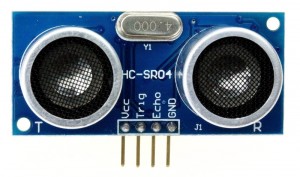Animals such as bats and porpoises use ultrasound for locating prey and obstacles. If you have an electronic device that needs to sense distances from objects (like a robot or an automatic door opener) you might consider using an HC-SR04 Sensor Module.
No one can sneak up on you with a couple of these and a buzzer attached to your favorite Arduino board. 🙄
The HC-SR04 module sends out an ultrasonic ‘PING’ and then detects its return after ‘bouncing off’ something in the distance. By measuring the round trip time (and knowing the speed that sound travels), a calculation can be made to determine the distance of the object from the HC-SR04.
Here is a public domain Ardunio sketch (the comments show the math involved to calculate the distances, they also show how the HC-SR04 is wired):
/* HC-SR04 Sensor
https://www.dealextreme.com/p/hc-sr04-ultrasonic-sensor-distance-measuring-module-133696
This sketch reads a HC-SR04 ultrasonic rangefinder and returns the
distance to the closest object in range. To do this, it sends a pulse
to the sensor to initiate a reading, then listens for a pulse
to return. The length of the returning pulse is proportional to
the distance of the object from the sensor.
The circuit:
* VCC connection of the sensor attached to +5V
* GND connection of the sensor attached to ground
* TRIG connection of the sensor attached to digital pin 7
* ECHO connection of the sensor attached to digital pin 6
Original code for Ping))) example was created by David A. Mellis
Adapted for HC-SR04 by Tautvidas Sipavicius
This example code is in the public domain.
*/
const int trigPin = 7;
const int echoPin = 6;
void setup() {
// initialize serial communication:
Serial.begin(9600);
}
void loop() {
// establish variables for duration of the ping,
// and the distance result in inches and centimeters:
long duration, inches, cm;
// The sensor is triggered by a HIGH pulse of 10 or more microseconds.
// Give a short LOW pulse beforehand to ensure a clean HIGH pulse:
pinMode(trigPin, OUTPUT);
digitalWrite(trigPin, LOW);
delayMicroseconds(5);
digitalWrite(trigPin, HIGH);
delayMicroseconds(15);
digitalWrite(trigPin, LOW);
// Read the signal from the sensor: a HIGH pulse whose
// duration is the time (in microseconds) from the sending
// of the ping to the reception of its echo off of an object.
pinMode(echoPin, INPUT);
duration = pulseIn(echoPin, HIGH);
// convert the time into a distance
inches = microsecondsToInches(duration);
cm = microsecondsToCentimeters(duration);
Serial.print(inches);
Serial.print("in, ");
Serial.print(cm);
Serial.print("cm");
Serial.println();
delay(500);
}
long microsecondsToInches(long microseconds) {
// According to Parallax's datasheet for the PING))), there are
// 73.746 microseconds per inch (i.e. sound travels at 1130 feet per
// second). This gives the distance travelled by the ping, outbound
// and return, so we divide by 2 to get the distance of the obstacle.
// See: http://www.parallax.com/dl/docs/prod/acc/28015-PING-v1.3.pdf
return microseconds / 74 / 2;
}
long microsecondsToCentimeters(long microseconds) {
// The speed of sound is 340 m/s or 29 microseconds per centimeter.
// The ping travels out and back, so to find the distance of the
// object we take half of the distance travelled.
return microseconds / 29 / 2;
}


Recent Comments